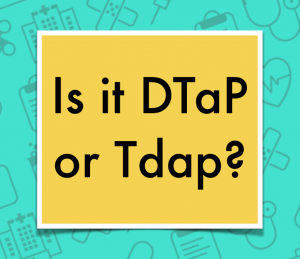What’s the difference between Tdap and DTaP?

The DTaP vaccine is for children 0-7 years and the Tdap vaccine is the booster given at age 11 and to adults age 19-64.
Both are inactivated bacterial vaccines that protect against diphtheria, tetanus, and acellular pertussis.
We consider Tdap to be a booster vaccine because of it’s
Since immunity wanes over time, the current recommendation is that everyone needs a booster for tetanus and diphtheria every ten years. This booster given to adults is called Td. It is also recommended that one dose of Tdap should be substituted for a Td dose in adults between 11 and 64 years.
If you are a woman who has had a child in the last few years or is pregnant, then you most likely (hopefully) have had the Tdap vaccine in your 2nd-3rd trimester. The current recommendation is that pregnant women are given the vaccine between 27-36 weeks’ gestation.
Getting the Tdap vaccine while pregnant is important and will help protect the baby from pertussis (whooping cough) in his first few months of life before he can get the DTaP vaccine at 2 months.
How do you remember the difference between DTaP and Tdap?
If the letter is capitalized then it’s a higher dose of the antigen.
Babies and children under seven are given the highest dose of this vaccine, therefore they get “DTaP”–all caps.
Tdap is a reduced version of diphtheria and acellular pertussis, therefore it’s T (high dose of tetanus), dap (reduced dose of diphtheria and pertussis)–Tdap.
Make sense? 🙂


